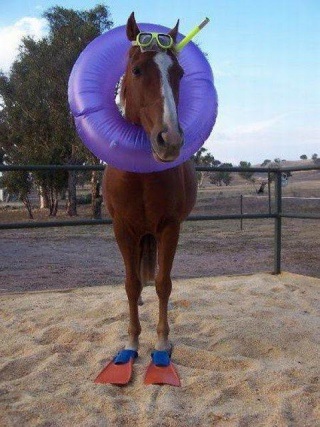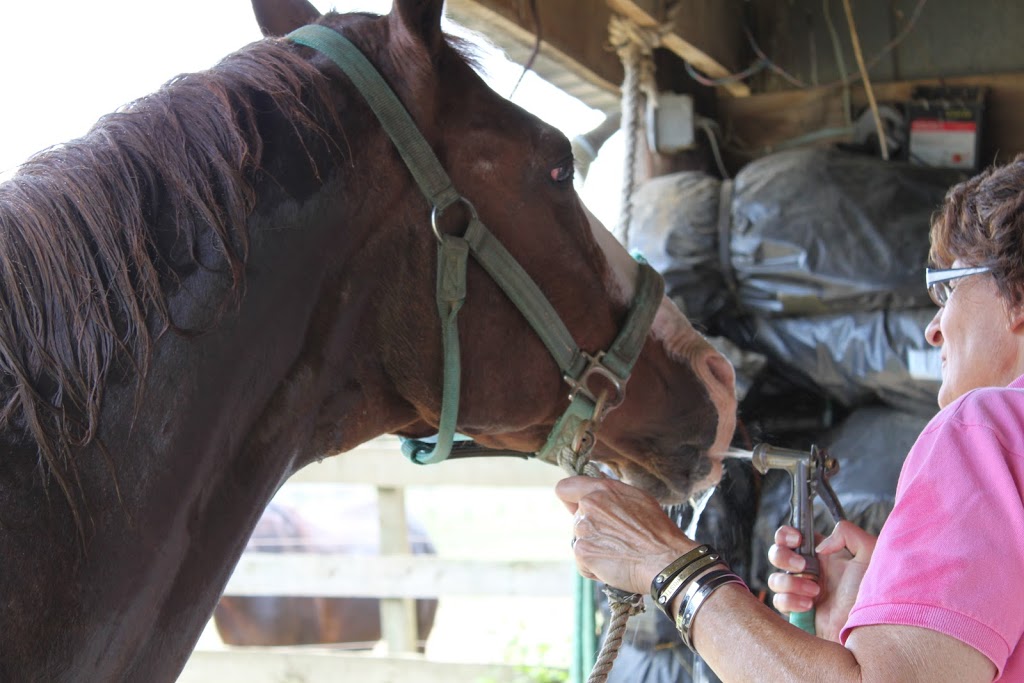How are you and your horse keeping cool during these hot and hazy summer days? While most of my human friends can enjoy air conditioning, I seek the shade of a tree or a run-in shed to keep cool. This heat is tough on any horse, and since I’m (a little) older than most, I have to be especially careful to ensure that I’m staying properly hydrated and that I’m consuming enough calories to keep my body functioning and maintain a healthy body weight. Staying hydrated (especially while exercising) on a hot day is very important…not only for humans but for horses too!
A source of clean water should be available at all times for your equine pals to guarantee good health and performance. Did you know that the average horse drinks between 8-10 gallons a day, but may go as high as 15-20 gallons during high-intensity training? That’s 720 glasses of water! If the horse sweats for a prolonged period of time during training or competition, it will need to drink more water and consume more electrolytes than normal to replace its losses. Electrolytes help cells communicate efficiently when the salts are separated into ions, such as potassium, sodium, chloride, and calcium, by our body’s water. All horses should also have a simple salt block. Although electrolytes for horses usually come in a solid or powdered form, many popular sports drinks contain electrolytes to help humans maintain their supply while exercising.
 So what’s all the fuss about maintaining a healthy body weight throughout the summer? Trust me, for horses, it has nothing to do with obtaining a svelte beach body to fit into our swim suits! Some horses may lose as much as 7-10 percent of body weight in sweat per hour in extreme temperatures. That’s about 9-10 gallons of horse sweat…gross! Dr. Malinowski keeps my diet high in calories by increasing my grain, adding corn oil to my feed, and feeding me a wide variety of…doughnuts! Keep in mind, horses that compete in athletic events should not be fed chocolate doughnuts. Also, go easy on the sweets for any horses that have Pituitary Pars Intermedia Dysfunction (PPID).
So what’s all the fuss about maintaining a healthy body weight throughout the summer? Trust me, for horses, it has nothing to do with obtaining a svelte beach body to fit into our swim suits! Some horses may lose as much as 7-10 percent of body weight in sweat per hour in extreme temperatures. That’s about 9-10 gallons of horse sweat…gross! Dr. Malinowski keeps my diet high in calories by increasing my grain, adding corn oil to my feed, and feeding me a wide variety of…doughnuts! Keep in mind, horses that compete in athletic events should not be fed chocolate doughnuts. Also, go easy on the sweets for any horses that have Pituitary Pars Intermedia Dysfunction (PPID).
You know, I have an affection for confections, but I think I’m speaking for all horses when I say that there’s nothing more satisfying than waking up early on a summer morning to find the pasture lush and glistening with dew drops…and then grabbing mouthfuls at a time like I’ve never eaten grass before in my life! The best way to ensure lush pastures for grazing in the summer is through careful maintenance throughout the year. The most effective way to do this is through “rotational grazing”. No, this doesn’t mean grazing in a circle! This just means rotating the paddocks where horses are turned out in order to prevent over grazing and allow the pasture a chance to grow. This way, during the summer months, grass will be thick, green, and delicious (not to mention nutritious)!
Another way to make sure your fields are prime for the summertime is to set up a “sacrifice area” horses can be turned out over the fall, winter, and spring without concern for over grazing. A sacrifice area, as well as the rotational grazing method, provides area where grass will have an opportunity to grow undisturbed. For more information on pasture management, visit the Ryders Lane Environmental Best Management Practices Demonstration Horse Farm webpage. Here you can play games, read articles, and take a virtual tour of the Ryders Lane farm! If you don’t mind getting a little dirty, stop by the Ryders Lane farm at the Rutgers-New Brunswick, G.H. Cook campus and see the best management practices in person…and maybe make some new equine friends as well!
For additional info on how to beat the heat, visit the eXtension HorseQuest website.
Do you have any tried and true tips on how to keep your horse happy and healthy during the grueling summer months? Share them with us in the comment box below!
Your Pal,
Lord Nelson


